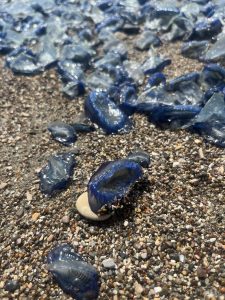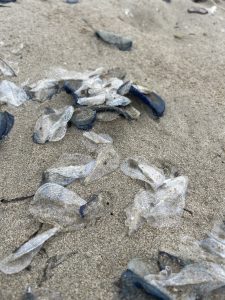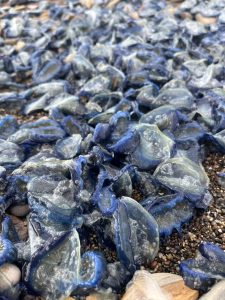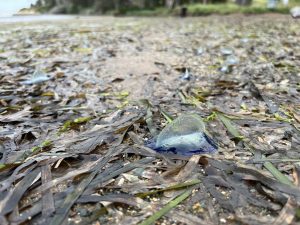If you have been visiting the California coast in the past few weeks, you may have noticed along the shorelines a unique, brilliantly blue-bodied creature with a clear ‘sail’. Velella velella, commonly known as velellas or by-the-wind sailors, are a hydrozoan (related to jellies and coral in the phylum Cnidaria) that spend most of their life in the open ocean.

By-the-Wind Sailors

When the springtime winds shift towards the California coastline, that’s when the velellas wash up on our shores. After they leave the water and die on the shore, their bright blue bodies fade translucent, and their texture becomes just like a plastic bag.
When Do We See Velellas?
It’s not every year that beaches are covered with these faded blue ocean frisbee-looking organisms. So what factors besides onshore wind cause these mass strandings? Storms like we saw this past winter and ocean currents play a role in where velella end up. Scientists also found that if the previous winter had warmer ocean temperatures, more velella strandings tend to occur.

In the Pacific Ocean, water temperatures are affected by episodic or extreme climatic events. El Niño, an episodic weather pattern that usually brings wetter conditions to California, often temporarily increases ocean temperatures by 0.5°C. The more extreme marine heat waves (MHW), like the ‘blob’ that occurred in 2014 and the current MHW being tracked since January 2022, can cause temperature increases almost 3°C above average ocean conditions. As the oceans continue to warm with climate change, these strandings could become more common.

What To Do If You Encounter Velella?
If you’re walking along the shoreline and spot these jelly-like friends, take a few pictures and upload them to a crowdsourced science platform, such as JellyWatch or iNaturalist. Your observation could help increase our understanding of the oceanic patterns behind velella strandings.
A brief safety note—although velellas don’t pack a deadly punch like their relatives the Portuguese man o’ war, their stinging cells may still cause irritation, so iNaturalist advises avoiding touching your face or eyes after handling them.
Help us protect and restore the Morro Bay estuary!
- Donate to the Estuary Program today and support our work in the field, the lab, and beyond.
The Estuary Program is a 501(c)3 nonprofit. We depend on funding from grants and generous donors to continue our work. - Support us by purchasing estuary-themed gear from ESTERO. This locally owned and operated company donates 20% of proceeds from its Estuary clothing line and 100% of Estuary decal proceeds to the Estuary Program. Thank you, ESTERO!
- Purchase items from the Estuary Program’s store on Zazzle. Zazzle prints and ships your items, and the Estuary Program receives 10% of the proceeds. Choose from mugs, hats, t-shirts, and even fanny packs (they’re back!) with our fun Estuary Octopus design, our classic Estuary Program logo, or our Mutts for the Bay logo.
Thank you for helping our beautiful, bountiful, biodiverse bay!